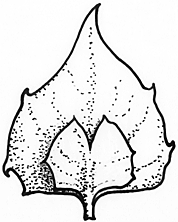Atriplex acutiloba R.H.Anderson APNI* 
Description: Erect annual or short lived, white to scaly perennial herb. Monoecious.
Elliptic, rhombic to oblong ovate, 2–5 cm long, 1–3 cm wide, margins deeply toothed, narrowing gradually into a petiole half the length of the lamina, scurfy to scurfy tomentose on both surfaces.
axillary, solitary or in small clusters or short disjunct spikes
Bracteoles more or less broad triangular, 4–6 mm long and wide, margins entire or regularly sinuate & prominently dentate, appendages usually two, fused at the base, semi-circular, inflated, sessile or subsessile, free to base, 0.5–1mm wide, more or less scurfy tomentose.Seed circular, radical erect.
Flowering: May to Sep.
Distribution and occurrence: 2 collections from near Broken Hill. More in SA. Presumed extinct in NSW. Habitat not recorded.
NSW subdivisions: NFWP, SFWP
Other Australian states: S.A.
Threatened species: NSW BCA: Presumed Extinct
This species is considered data-deficient by Saving our Species (SoS, DPIE) which means a conservation project cannot be developed for it. Visit their website and contact SoS if you have additional information.
Text by B.M. Wiecek
Taxon concept: Flora of NSW 1 (1990), Fl. Aust. Vol 4 (1984), Flora of Victoria, Vol 3 (1996), Plants of Western NSW (1992), Flora South Australia Vol 1 (1986)
APNI* Provides a link to the Australian Plant Name Index (hosted by the Australian National Botanic Gardens) for comprehensive bibliographic data
***The AVH map option provides a detailed interactive Australia wide distribution map drawn from collections held by all major Australian herbaria participating in the Australian Virtual Herbarium project.
|


